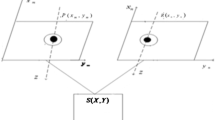Abstract
This paper concerns the quality assessment of the 3D rendering in a production process of auto-stereoscopic images using a multi-view camera with parallel and decentring configuration. The 3D rendering quality problem for such process is related to the coherence of the captured images of different viewpoints. This coherence depends, among others, on a rigorous respect of the shooting and rendering geometries. Assuming perfect rendering conditions, we are rather interested in the shooting geometry and image sensors positioning. This latter must be accurate enough to produce images that are quite coherent with each other and that contribute fully to achieve a quality 3D content. The purpose of this paper is precisely to study the positioning accuracy of the different geometrical parameters of shooting based on a quality assessment of auto-stereoscopic rendering. For the assessment of the 3D rendering quality and in order to determine a positioning accuracy of the different components of the considered multi-view camera, two different approaches are proposed. The first one is based on visual assessment tests of the 3D rendering quality by human observers. The second one is based on the acquired scientific knowledge on human visual acuity. Finally, some simulation and experimental results and their repercussion on the positioning accuracy of the shooting parameters are presented.
Similar content being viewed by others
References
Ali-Bey, M., Manamanni, N., & Moughamir, S. (2010a). Dynamic Adaptation of Multi View Camera Structure. In 3DTV-conference: The true vision—capture, transmission and display of 3D video (3DTV-CON’10), Tampere, Finland.
Ali-Bey, M., Moughamir, S., & Manamanni, N. (2010b). Towards structurally adaptive multi-view shooting system. In 18th Mediterranean conference on control and automation (MED), Marrakesh, Morocco.
Benoit, A., Le Callet, P., Campisi, P., & Cousseau, R. (2008). Quality assessment of stereoscopic images. Hindawi, EURASIP Journal on Image and Video Processing. doi:10.1155/2008/659024.
Blach, R., Bues, M., Hochstrate, J., Springer, J., & Fröhlich, B. (2005). Experiences with multi-viewer stereo displays based on lc-shutters and polarization. In Proceedings of IEEE VR workshop: Emerging display technologies.
Dodgson, N. A. (2002). Analysis of the viewing zone of multi-view autostereoscopic displays. In Stereoscopic displays and virtual reality systems IX, vol. 4660 of Proceedings of SPIE, pp. 254–265.
Dubois, E. (2001). A projection method to generate anaglyph stereo images. In Proceeding of IEEE international conference acoustics, speech, and signal processing (ICASSP ’01), vol. 3, pp. 1661–1664, IEEE Computer Society Press.
EBU Project Group B/VIM Video in Multimedia. (2003). SAMVIQ: Subjective assessment methodology for video quality.
Graham, J., Delman, L., Nicolas, H., & David, E. (2001). Controlling perceived depth in stereoscopic images. In Proceeding of SPIE stereoscopic displays and virtual reality systems VIII (Vol. 4297, pp. 42–53).
Güdükbay U., Yilmaz T. (2002) Stereoscopic view-dependent visualization of terrain height fields. IEEE Transactions on Visualization and Computer Graphics 8(4): 330–345
IJsselsteijn W. A., de Ridder H., Vliegen J. (2000) Subjective evaluation of stereoscopic images: Effects of camera parameters and display duration. IEEE Transactions on Circuits and Systems for Video Technology 10: 225–233
Kilner J., Starck J., Guillemaut J. Y., Hilton A. (2009) Objective quality assessment in free-viewpoint video production. Signal Processing: Image Communication 24(1–2): 3–16
Meesters L. M. J., IJsselsteijn W. A., Seuntiëns P. J. H. (2004) A survey of perceptual evaluations and requirements of three-dimensional TV. IEEE Transactions on Circuits and Systems for Video Technology 14(3): 381–391
Müller, K., Smolic, A., Dix, K., Merkle, P., Kauff, P., & Wiegand, T. (2008). View synthesis for advanced 3D video systems, Hindawi Publishing Corporation, EURASIP Journal on Image and Video Processing.
Perlin, K., Paxia, S., & Kollin, J. S. (2000). An autostereoscopic display. In Proceedings of the 27th ACM annual conference on computer graphics (SIGGRAPH ’00) (Vol. 33, pp. 319–326).
Prévoteau, J., Chalençon-Piotin, S., Debons, D., Lucas, L., & Remion, Y. (2010). Multi-view shooting geometry for multiscopic rendering with controlled distortion. International Journal of Digital Multimedia Broadcasting, 2010, 1–11. doi:10.1155/2010/975674.
Sanders, W., & McAllister, D. F. (2003). Producing anaglyphs from synthetic images. In Stereoscopic displays and virtual reality systems X, Vol. 5006 of Proceedings of SPIE, pp. 348–358.
Zanlonghi, X., & Sander, M.-S. (1999). Validation théorique d’une planche logarithmique d’acuité visuelle de loin pour enfant. J. Fr. d’Orthoptique.
Author information
Authors and Affiliations
Corresponding author
Rights and permissions
About this article
Cite this article
Ali-Bey, M., Manamanni, N. & Moughamir, S. Quality assessment of auto-stereoscopic rendering depending on positioning accuracy of multi-view capture systems’ components. Multidim Syst Sign Process 24, 255–279 (2013). https://doi.org/10.1007/s11045-012-0195-2
Received:
Revised:
Accepted:
Published:
Issue Date:
DOI: https://doi.org/10.1007/s11045-012-0195-2




